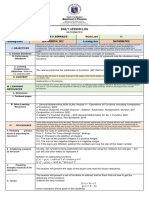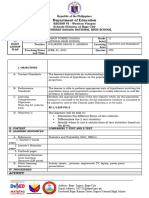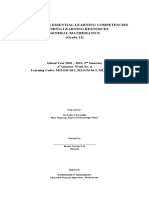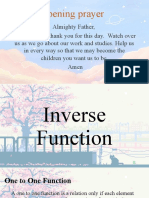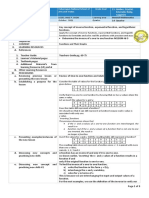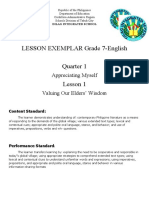Addition of Functions
Uploaded by
April Dio BornalesAddition of Functions
Uploaded by
April Dio BornalesRepublic of the Philippines
Department of Education
REGION VI- WESTERN VISAYAS
D IV ISI ON OF ES C ALA NTE CITY
E SC AL A NT E NAT I ON AL HI G H SC H O OL
DAILY LESSON LOG
MATHEMATICS
Teacher APRIL ROSE D. BORNALES Grade Level 11
Teaching Dates SEPTEMBER 5, 2022 Learning Area MATHEMATICS
Objectives must be met over the week and connected to the curriculum standards. To meet the objectives, necessary procedures must be
followed and if needed, additional lessons, exercises and remedial activities may be done for developing content knowledge and
I. OBJECTIVES competencies. These are assessed using Formative Assessment strategies. Valuing objectives support the learning of content and
competencies and enable children to find significance and joy inlearning the lessons. Weekly objectives shall be derived fro m the curriculum
guides.
A. Content Standards The learner demonstrates an understanding of key concepts of functions.
B. Performance The learner can accurately construct mathematical models to represent real-life situations using
Standards functions.
C. Learning
Competencies /
The learner performs the addition of functions. (M11GM-Ia-3.1)
Objectives Write the
LC code for each
Content is what the lesson is all about. It pertains to the subject matter that the teacher aims to teach. In the CG, the content can be tackled
II. CONTENT in a week or two.
Addition of Functions
List the materials to be used in different days. Varied sources of materials sustain children’s interest in the lesson and in learning. Ensure
III. LEARNING that there is a mix of concrete and manipulative materials as well as paper-based materials. Hands-on learning promotes concept
RESOURCES development.
A. References
1. Textbook pages
B. Other Learning 1. General Mathematics ADM SLMs: Module 3 – Operations of Functions (including Composition
Resources of Functions), 2020
2. Rowena Olofernes Youtube Channel – Addition, Subtraction, Multiplication, Division, and
Composition of Functions, 2021
3. DepEd TV Youtube Channel – SHS General Mathematics Q1 Ep 1: Function, 2021
4. General Mathematics, Rex Bookstore, 2016
These steps should be done across the week. Spread out the activities appropriately so that students will learn well. Always be guided by
demonstration of learning by the students which you can infer from formative assessment activities. Sustain learning systema tically by
IV. PROCEDURES providing students with multiple ways to learn new things, practice their learning, question their learning processes, and draw conclusions
about what they learned in relation to their life experiences and previous knowledge. Indicate the time allotment for each step.
A. Reviewing previous Review the rules in adding integers -
lesson or presenting the Rules:
new lesson 1. The sum of two positive integers is a positive integer.
2. The sum of two negative integers is a negative integer.
3. If the signs are different, subtract the numbers and use the sign of the larger number.
B. Establishing a purpose Usually, two functions being added are represented using the notations f(x) and g(x) – but can
for the lesson still use other letters to represent it.
Notation in adding functions:
𝑓 (𝑥 ) + 𝑔(𝑥) – read as “f of x plus g of x”
or (𝑓 + 𝑔)(𝑥) – read as “f plus g of x”
C. Presenting
examples/ instances of the The teacher will present the topic of the lesson and read the lesson objectives.
new lesson
The teacher will present a set of functions to add and let them find out how to get the sum of the
functions.
Add the two functions:
D. Activity 𝑓 (𝑥 ) = 3𝑥 + 2
𝑔(𝑥 ) = 4 − 5𝑥
(more examples will be given to the students)
E. Analysis After the allotted time, the teacher will check the students’ solutions. The teacher will also ask
the following questions to know the process of adding functions:
1. What is your process of adding the two functions?
-write the sum based on the notation
-arrange the terms
-combine like terms
-find the sum
The teacher will present two ways of adding the functions: Horizontal Addition and Vertical
Addition
1. Answer: (𝑓 + 𝑔)(𝑥) = −2𝑥 + 6 or (𝑓 + 𝑔)(𝑥) = −2(𝑥 − 3)
F. Abstraction The students will be able to sum up the lesson with these concepts:
1. The sum of the functions can be written as "𝑓(𝑥 ) + 𝑔(𝑥 )" or "(𝑓 + 𝑔)(𝑥)".
2. You can add functions horizontally or vertically by arranging the terms according to their
degrees.
3. The steps in adding functions are:
3.1 Write the functions into (𝑓 + 𝑔)(𝑥) = 𝑓 (𝑥 ) + 𝑔(𝑥 ),
3.2 Reorder the functions by degree of terms, and
3.3. Add functions horizontally or vertically.
G. Application The teacher will present two sets of functions for students to answer. They will apply the skills
they acquired in the lesson.
1. Find (𝑓 + 𝑔)(𝑥):
𝑓 (𝑥 ) = 4𝑥 + 2𝑥 2 − 2
𝑔(𝑥 ) = 4 − 3𝑥
Answer:
(𝑓 + 𝑔)(𝑥) = 2𝑥 2 + 𝑥 + 2
2. Find (𝑓 + 𝑔)(𝑥):
𝑓 (𝑥 ) = 3𝑥 + 3
𝑔(𝑥 ) = −4𝑥 + 1
1. Answer: (𝑓 + 𝑔)(𝑥 ) = −𝑥 + 4
H. Evaluating learning The teacher will give a 4-item test. It composes of a set of 4 functions to add.
1. (𝑓 + 𝑔)(𝑥):
f(x) = 2x+3
g(x) = 4x+7
2. (𝑓 + 𝑔)(𝑥):
f(x) = 6x-5
g(x) = 3x+9
3. (𝑓 + 𝑔)(𝑥):
f(x) = 4𝑥 2+3x+8
g(x) = 9𝑥 2-5x+12
4. (𝑓 + 𝑔)(𝑥):
f(x) = 2𝑥 3-3x-8
g(x) = 6x+11
Prepared by: Checked by:
APRIL ROSE D. BORNALES ESTELA R. KHEY______
Subject Teacher – TII Mentor – Master Teacher I
You might also like
- Semi-Detailed Lesson Plan in Science Grade 6: Questions To Ask100% (8)Semi-Detailed Lesson Plan in Science Grade 6: Questions To Ask5 pages
- Warm Up: Simplify. Assume That All Expressions Are Defined100% (2)Warm Up: Simplify. Assume That All Expressions Are Defined35 pages
- Daily Lesson Log CORE - GAS - General MathematicsNo ratings yetDaily Lesson Log CORE - GAS - General Mathematics5 pages
- Monday Tuesday Wednesday Thursday Friday: I. ObjectivesNo ratings yetMonday Tuesday Wednesday Thursday Friday: I. Objectives6 pages
- First Periodical Examination (Final) in Gen Math Sy 2019-2020No ratings yetFirst Periodical Examination (Final) in Gen Math Sy 2019-20205 pages
- Random Variables: Define A Random Variable Find The Possible Values of A Random VariableNo ratings yetRandom Variables: Define A Random Variable Find The Possible Values of A Random Variable20 pages
- Region VIII Schools Division of Tacloban City DLC V Sto. Niño Extension, Tacloban CityNo ratings yetRegion VIII Schools Division of Tacloban City DLC V Sto. Niño Extension, Tacloban City3 pages
- WSLP-General Mathematics Week 7 - ExponentialNo ratings yetWSLP-General Mathematics Week 7 - Exponential13 pages
- General Math DLL For SHS - (More DLL at WWW - Depedtambayanph.net) ) Q1, Week 06No ratings yetGeneral Math DLL For SHS - (More DLL at WWW - Depedtambayanph.net) ) Q1, Week 066 pages
- Mathematics Essential Learning Competencies Teaching-Learning Resources General Mathematics (Grade 11)No ratings yetMathematics Essential Learning Competencies Teaching-Learning Resources General Mathematics (Grade 11)28 pages
- SHS Core Subjects Matrix For The Learning Continuity Plan GenMath - DINCYNo ratings yetSHS Core Subjects Matrix For The Learning Continuity Plan GenMath - DINCY4 pages
- Activity On Null and Alternative HypothesisNo ratings yetActivity On Null and Alternative Hypothesis1 page
- Daily Lesson Plan 11-Amber, Crystal, Emerald, Ruby, SapphireNo ratings yetDaily Lesson Plan 11-Amber, Crystal, Emerald, Ruby, Sapphire3 pages
- 1. LESSON PLAN FINAL -G11 Stat and Probalility-Random VariableNo ratings yet1. LESSON PLAN FINAL -G11 Stat and Probalility-Random Variable4 pages
- Weekly Home Learning Plan: Lumil Integrated National High School100% (1)Weekly Home Learning Plan: Lumil Integrated National High School3 pages
- Lesson Plan in Statistics and Probability 11: Lim-Ao National High SchoolNo ratings yetLesson Plan in Statistics and Probability 11: Lim-Ao National High School3 pages
- Monday Tuesday Wednesday Thursday Friday: I. ObjectivesNo ratings yetMonday Tuesday Wednesday Thursday Friday: I. Objectives6 pages
- Unit I Lesson 4 Computing The Variance of A Discrete Probability DistributionNo ratings yetUnit I Lesson 4 Computing The Variance of A Discrete Probability Distribution23 pages
- LESSON 9: One-to-One Functions: Learning Outcome (S) : Lesson OutlineNo ratings yetLESSON 9: One-to-One Functions: Learning Outcome (S) : Lesson Outline6 pages
- Mangaldan National High School Mangaldan, Pangasinan Budgeted Lesson in Statistics & Probability100% (1)Mangaldan National High School Mangaldan, Pangasinan Budgeted Lesson in Statistics & Probability14 pages
- Demonstration Teaching Learning Plan School Barahan NHS Grade Level Teacher Gerson T. Acosta Sr. Learning Area Teaching Dates and Time QuarterNo ratings yetDemonstration Teaching Learning Plan School Barahan NHS Grade Level Teacher Gerson T. Acosta Sr. Learning Area Teaching Dates and Time Quarter6 pages
- Saint Vincent de Paul Diocesan College: Teaching Guide100% (1)Saint Vincent de Paul Diocesan College: Teaching Guide32 pages
- EDU301 General Methods of Teaching (HANDOUTS)No ratings yetEDU301 General Methods of Teaching (HANDOUTS)201 pages
- LESSON EXEMPLAR Grade 7-English Quarter 1 Lesson 1: Appreciating Myself100% (1)LESSON EXEMPLAR Grade 7-English Quarter 1 Lesson 1: Appreciating Myself5 pages
- Teaching Social Studies in The Elem Grades 5100% (3)Teaching Social Studies in The Elem Grades 523 pages
- Morning Session: Teaching Load School Year 2019 - 2020No ratings yetMorning Session: Teaching Load School Year 2019 - 202028 pages
- Lemery Colleges: Essential Elements of The PortfolioNo ratings yetLemery Colleges: Essential Elements of The Portfolio3 pages
- FINAL - PROJECT - ADTA - 5900 - 5550 - 701 - Peer - Evaluation - Form 1No ratings yetFINAL - PROJECT - ADTA - 5900 - 5550 - 701 - Peer - Evaluation - Form 12 pages
- Personalized Federated Learning With First Order Model OptimizationNo ratings yetPersonalized Federated Learning With First Order Model Optimization17 pages
- Effects of E-Learning On Students MotivationNo ratings yetEffects of E-Learning On Students Motivation9 pages
- (개정) 2022년 - 영어 독해와 작문 - YBM (신정현) - 6과 - 적중예상문제 2회 심화 - OKNo ratings yet(개정) 2022년 - 영어 독해와 작문 - YBM (신정현) - 6과 - 적중예상문제 2회 심화 - OK13 pages
- President Ramon Magsaysay State University: Telefax: 047-8111683/email Address: Prmsu - Edu.phNo ratings yetPresident Ramon Magsaysay State University: Telefax: 047-8111683/email Address: Prmsu - Edu.ph22 pages
- Longman Young Children's Picture Dictionary - Activity Resource Book (WWW - Languagecentre.ir)No ratings yetLongman Young Children's Picture Dictionary - Activity Resource Book (WWW - Languagecentre.ir)129 pages


